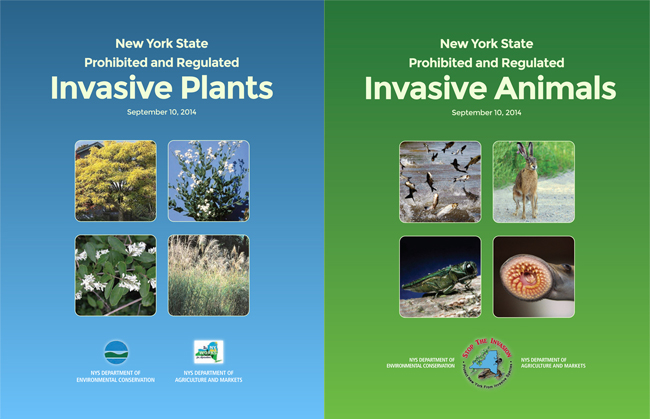Albany, NY, July 1, 2015 - Two revised full-color publications - produced by the New York State Department of Environmental Conservation with assistance from New York Sea Grant, among others - list all the State's banned and regulated plants and animals.
The updated booklets were released in Spring and Summer 2015 in tandem with new statewide regulations that, in March, banned the sale, purchase and transportation of a long list of invasive plants.

The list of 69 banned plants includes some home and commercial landscaping favorites such as Japanese barberry, autumn olive, privet, multiflora rose, yellow iris, and several types of bamboo, spurge and honeysuckle.
The list also includes the invasive vines porcelain berry and Oriental bittersweet, the two vines that are attached like hairnets to so many of the beautiful trees along the Saw Mill, Taconic and Palisades parkways. These vines may have begun their life on suburban backyard trellises, and then they escaped into the woods and are now strangling and pulling down the trees.
The banned plants include many well-known enemies in our meadows and forests such as purple loosestrife, garlic mustard, kudzu, Japanese knotweed, giant hogweed, mile-a-minute vine, and Japanese stiltgrass.
The regulations do not require homeowners, nature preserves or municipalities to go in and pull out existing invasive plants.
Along with invasive plants, there is also a ban on other invasive species, including 15 fish, 17 aquatic invertebrates (snails and clams), 13 terrestrial invertebrates (insects such as the Asian longhorn beetle and hemlock wooly adelgid), five vertebrates (such as the mute swan) and seven species of algae, fungi and bacteria.
Another 29 species — including the hugely popular foundation shrub Euonymus alatus, also known as burning bush, and Norway maple trees — will be "regulated," meaning that they can't knowingly be introduced on or near public lands or natural areas.
A one-year grace period was included in the regulations for Japanese barberry (Berberis thunbergii), during which time nurseries can sell existing stock.
More Info: New York Sea Grant
New York Sea Grant (NYSG), a cooperative program of Cornell University
and the State University of New York, is one of 33 university-based
programs under the National Sea Grant College Program (NSGCP) of the
National Oceanic and Atmospheric Administration (NOAA). The NSGCP
engages this network of the nation’s top universities in conducting
scientific research, education, training and extension projects designed
to foster science-based decisions about the use and conservation of our
aquatic resources. Through its statewide network of integrated
services, NYSG has been promoting coastal vitality, environmental
sustainability, and citizen awareness about the State’s marine and Great
Lakes resources since 1971.
New York Sea Grant maintains Great Lakes offices at SUNY Buffalo, the
Wayne County Cooperative Extension office in Newark and at SUNY Oswego.
In the State's marine waters, NYSG has offices at Stony Brook University
and Stony Brook Manhattan, in the Hudson Valley through Cooperative
Extension in Kingston and at Brooklyn College.
For updates on Sea Grant activities: www.nyseagrant.org has RSS, Facebook, Twitter, and YouTube links. NYSG also offers a free e-list sign up via www.nyseagrant.org/coastlines for its flagship publication, NY Coastlines/Currents, which is published several times a year.